How does pomegranate grow, where is it grown and when does it ripen?
In the East, pomegranate is called the royal fruit for its excellent taste and beautiful appearance. One fruit contains most of the nutrients needed by the human body. In folk medicine, pomegranate seeds and peel are used to treat anemia, dysentery, gastrointestinal disorders and other diseases.
Pomegranate trees are grown on an industrial scale in many countries and cities with a subtropical climate. Trees are demanding on the climate, but are unpretentious in care. Where pomegranate is grown, how it grows in nature and when the fruits ripen - read on.
Description and characteristics of pomegranate
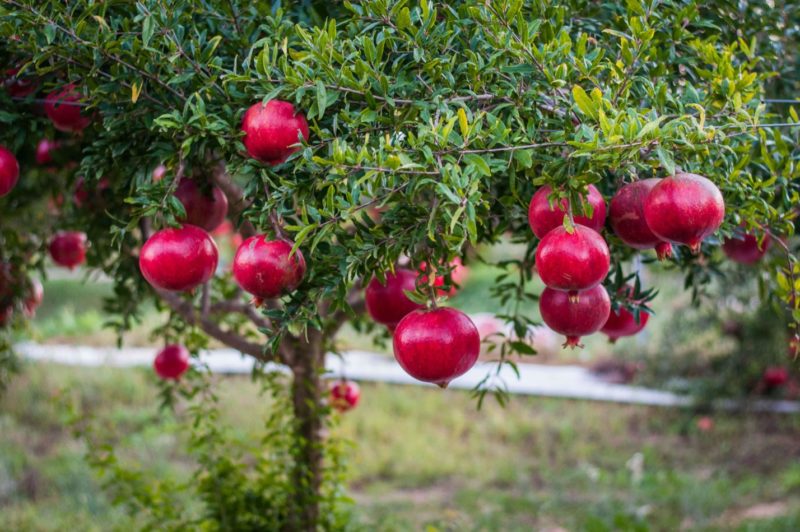
Pomegranate is a long-lived plant from the Derbennikov family, genus Pomegranate. On average, it actively grows and bears fruit for about 100 years. In nature, there are trees that are about 300 years old.
When grown on an industrial scale every 50-60 years, pomegranates landings cut down and replaced with new plants, since by this time the crop yield is reduced.
This is interesting! During the Middle Ages, the pomegranate was called Pomum granatus, which translates as “seed apple.” In Ancient Rome, the plant was called Malum granatus - “grainy apple”. Later, C. Linnaeus gave the culture an official name - Punica granatus, which translates as “Punian granular”. From Italian and German, the name of pomegranate is still translated as “apple”.
For comfortable growth, pomegranate trees require a subtropical climate. The plant can withstand cold temperatures down to -15°C, and at temperatures of -20°C and below, its entire above-ground part freezes over.
The plant loves light, so it is planted in open areas. To make the fruits large and sweet, they must be shaded by leaves. This is taken into account when forming the crop crown.
Pomegranate is not picky about soil composition. Able to grow even on sandy and saline soils.
The plant is hardy and famous for its sleeplessness. If the trunk and branches of a tree are completely covered with sand, it will sprout new adventitious roots, and the old root system will gradually dry out. This is proven by a cemetery of pomegranates with multiple rooting of tiers along the trunk, found near the Ganja-Gai River.
Pomegranate is not picky about watering and humidity. It tolerates drought well. However, to improve fruiting, it is recommended to spray the crown. On dry days, the soil is periodically moistened.
Like all cultivated plants, pomegranate is susceptible to diseases and pest attacks. It is most often affected by Phomopsis (twig cancer) and sooty fungus. Among the pests, the most common problem is considered to be pomegranate mite, carnation leaf roller, corrosive woodworm, pomegranate codling moth, and aphid.
Breeders are constantly developing new varieties of pomegranate with increased resistance. When grown on an industrial scale, the problem is combated with the help of chemicals.
Botanical description
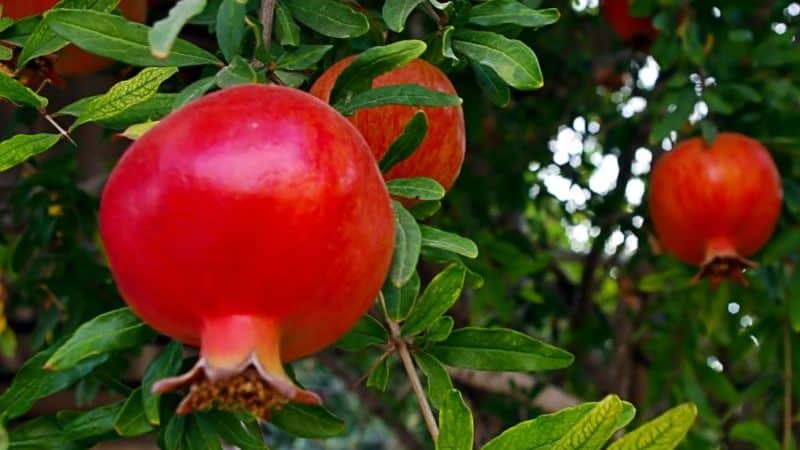
Pomegranate is not only a source of tasty and useful fruits. Trees look aesthetically pleasing during flowering and fruiting periods.
Cultivated varieties are usually grown in tree form 3-6 cm high.In the wild, the type of plant depends on the conditions and method of formation; in mountainous areas and with a lack of soil, pomegranate grows like a shrub.
Pomegranate branches are thin, but flexible and strong, capable of supporting heavy fruits. They have thorns on them. The closer the plant is to the wild form, the longer and sharper the thorns on the branches.
The leaves are opposite, elongated, pointed on both sides, glossy, bright green. The maximum length is 8 cm, and the width is 2 cm. In the tropics it grows as an evergreen tree, and in countries with cold winters it sheds its leaves when frost occurs.
Flowers 2 types. Bell-shaped specimens are sterile. They do not have ovaries and fall off after the plant has flowered. There are most of these flowers on the tree. The pitcher-shaped specimens are bisexual and have a noticeable ovary at the base. It is from them that fruits are formed.
There are flowers of intermediate forms. In the fruit pomegranate they are red-orange, simple, have a leathery cup with 5-7 pointed lobes. It contains thin, delicate petals, stamens and a style with a thickened, lobed stigma. In decorative varieties of the plant, flowers can be simple or double, in red, pink, white and variegated shades.
The fruits are spherical in shape, with a retained leathery, crown-shaped pericarp. The scientific name of pomegranate berries is pomegranates.. The hard peel, which reliably protects the pulp from damage, can be red (the most common option), yellow, orange, brown, brown. It is inedible, but is actively used in medicine and cosmetology.
Beneath the skin are numerous pomegranate seeds, which are seeds surrounded by juicy pulp. It comes in dark and light red, pink or yellow.It tastes sour, sweet, sour-sweet.
The seeds are numerous. Their number can reach 1200. They are located in 6-13 chambers, separated by a dense cream-colored film. Bones can be hard or soft. Reproduction by a generative method is possible.
This is interesting! About 60 kg of fruits are harvested from one pomegranate tree per season.
Origin and historical homeland
Scientists believe that pomegranate is an ancient crop, dating back at least 4 thousand years. It is believed that the fruits of the plant used for food ancient people of the stone age.
Persia (modern Iran) is considered the historical homeland of culture. Also in ancient centuries, the plant was distributed wild in Carthage (modern Tunisia), Afghanistan, Turkey, Transcaucasia, and Central Asia.
Pomegranate trees have been cultivated since ancient times and are distributed throughout the Mediterranean. The culture was brought to America during the time of the Spanish conquistadors. Later, the plant spread throughout all countries and cities with a subtropical climate.
Pomegranate was especially revered in Greece. It was sung by poets, and the best warriors were awarded fruits cast in gold. Mention of the grainy apple appears in the Old Testament.
This is interesting! Some peoples believe that the pomegranate was the apple that seduced Eve in the Garden of Eden.
How does wild pomegranate grow?
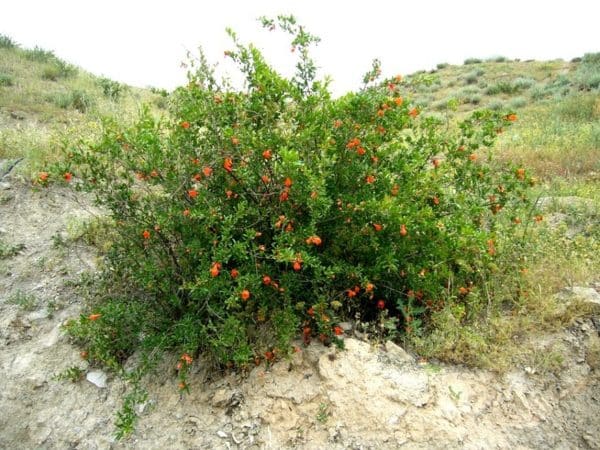
Wild pomegranate thickets are most often found along ridges, near mountain rivers, on rocky, sandy and pebble-alluvial soils.
In favorable conditions, the plant grows into a tall tree. On mountain slopes it becomes shrub. The more favorable the conditions for growth, the higher the culture.
The fruits of wild pomegranate are smaller than cultivated ones. They have a sweet and sour tart taste.The peel is bright red or orange with light spots. The grains are light red. The seeds are hard.
Geographical areas of pomegranate cultivation
The countries where pomegranate grows have a mild subtropical climate. The plant is found both in wild and cultivated forms.
The natural habitat includes Western Asia: Turkey, Armenia, Abkhazia, Iran, Azerbaijan, Georgia, Afghanistan, Turkmenistan.
The northern border of the range affects the Asian countries of the former USSR, the Greater Caucasus Range, and the coast of the Caspian Sea. The western limits touch the coast of Asia Minor. The southern borders reach the shores of the Arabian Sea.
Cultivated pomegranate plantations grow in the Middle East, Greece, Afghanistan, Iran, Italy, Spain, Armenia, Uzbekistan, Georgia, Azerbaijan, France, Portugal, and Tajikistan. The plant is actively cultivated in the region of the former Yugoslavia.
The cultivated pomegranate is also found in Russia: in North Ossetia, Crimea, Dagestan, Krasnodar Territory, Sochi.
To the question of whether pomegranates grow in Abkhazia, the answer will be positive.
Where does the most delicious pomegranate grow?
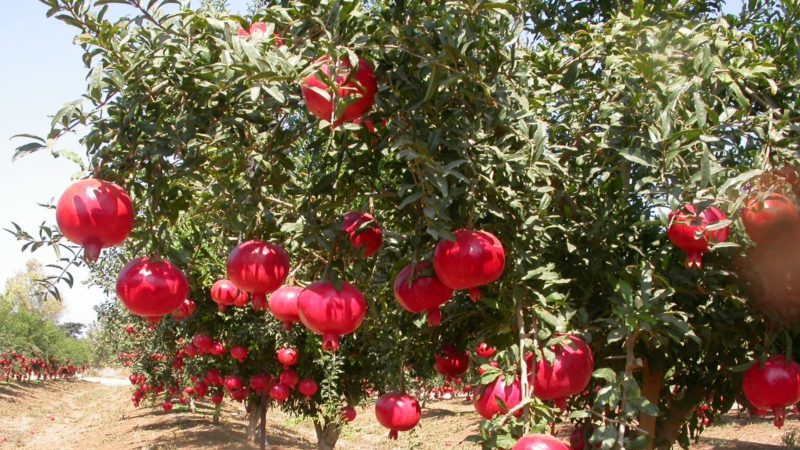
There is no clear answer to the question of where the most delicious pomegranate grows. Residents of different countries have different opinions on this matter.
Azerbaijani pomegranate is famous for its high taste characteristics. In Azerbaijan, in the city of Goychay, a pomegranate fruit festival is traditionally held. And it is the Goychay pomegranate that enjoys the greatest love among the inhabitants of the country.
It is also widely believed that the most delicious pomegranate grows in Iran, the historical homeland of the culture. The Greeks will not agree with this statement, for whom Tunisia has been the center of the most valuable grain apples since ancient times.
Note! The taste of the fruit is influenced not by how and where the pomegranate grows, but by the variety of a particular plant. There are sweet, sour and sweet and sour varieties. Also, fruits that grow in favorable conditions, on fertile soil and ripen at a temperature of +25°C have the best taste.
Zoning of pomegranate by types and varieties
There are only 3 types of pomegranate in the world:
- Ordinary. Gives the most delicious fruits. It was from him that all cultivated varieties came. It grows wild in western Asia and southern Europe.
- Socotrans. It grows in the Arabian Sea on the island of Socotra. The taste of this variety of crop is lower than that of an ordinary pomegranate. Therefore, the plant is found in the wild, but is not cultivated.
- Dwarf. It was isolated relatively recently as a separate species. Produces a large number of small fruits. Grown as a home and ornamental plant.
The taste of the fruit is largely influenced by the variety. The list shows the main varieties of pomegranate and the countries in which they are grown:
- Aswad, Sharodi, Akhmar, Halva. Cultivated in Iran. The taste of the pulp is sweet, practically without sourness.
- Wonderful. A variety characterized by soft seeds. Popular in America.
- Malissi, Mangulati, Ras el Bahl, Red Loufani. Grown in Israel. The taste is sweet, with a slight sourness.
- Red galoshes, Bela-Mursal, Kyrmyzy-kabukh, pink galoshes, Veles, Shah-par, Kaim-nar. Sweet and sour varieties. They have a tart, rich taste. They grow in Crimea and Transcaucasia.
- Bedana, Dholka, Alandi. The pulp of the fruit is very sweet. The varieties are characteristic of India.
- Achik-Dona, Kazake-Anar, Kzyl-Anar. A sweet and sour variety of pomegranate. The varieties are actively cultivated in Central Asian countries. Ripen in October.
- Kok, Ulfa, Kyzym, Wellis.They have a sweet and sour tart taste.
- Lojuar, Vedana, Kadan, Nar-Shirin. One of the sweetest varieties. Popular all over the world.
- Ulfi, Ak-Dona, Lor-Zhuar. The sweetest varieties from the early ones. Distributed throughout the world. In most countries they ripen already in September.
The most popular decorative varieties are Multiplex, Chico, and Variegata. They don't bear fruit, but they bloom beautifully.
When does pomegranate ripen?
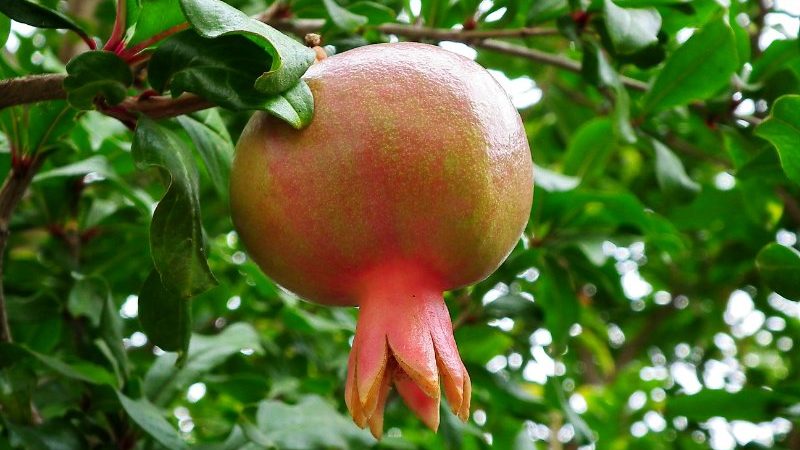
The first pomegranate harvest is harvested when the plant is 3-4 years old. If the tree was propagated vegetatively, then already in the second year. After this, the tree continues to bear fruit for more than 100 years, but the highest yields are observed in the first 55-60 years.
The growing season lasts from 6 to 8 months. The crop has a long season of flowering, fruiting and fruit ripening. From formation to full maturity it takes from 4 to 5 months.
In hot countries, when a pomegranate ripens, it cracks right on the branches if it has not been removed from the tree earlier, but the grains do not spill out. Such fruits are not suitable for transportation, but have a rich taste, so they are a pleasure to eat. use local residents.
In countries with colder climates, the leaves partially fall off when pomegranates ripen. Large bright fruits on bare branches look especially unusual.
The ripening season of pomegranates depending on the place of growth:
- Crimea. Pomegranate is found not only in gardens, but also in public gardens and city parks. The fruits ripen for about a month, from the beginning of October.
- When does pomegranate ripen? in Azerbaijan? Here the harvest begins on October 26 and ends on November 7. At this time, a pomegranate fair is held in the country.Azerbaijani fruits are not distinguished by their perfectly even shape or smooth shiny skin, but they have a rich, sweet taste.
- In Turkey. This is the main exporter of pomegranates to Russia. Large round glossy fruits with bright skin grow here. The ripening of the Turkish harvest continues from the second half of September until the end of October.
- Armenia. The season begins in mid-October and continues until late autumn. Very sweet and juicy fruits grow here.
- Abkhazia and Georgia. Fruit ripening also occurs in mid-October.
- Tajikistan. The fruits begin to be harvested as early as October 10; later varieties ripen by the end of the month.
- Israel. The pomegranate harvest season in Israel lasts from August to February, depending on the variety. It is one of the main exporters of red granular fruits. The main buyer of Israeli garnets is Russia.
- Sochi. The ripening period lasts from October to early November.
- Dagestan. Earlier fruiting is observed here. The first pomegranates can be tasted in the second half of September.
- Iran. More than 100 varieties of pomegranate are grown here. Ripening of the early ones begins at the end of September, the bulk ripens from mid-October to the end of November. In mid-November there is a pomegranate festival called “One Hundred Grains of Ruby”.
- Tunisia. The juicy and sweet fruits are harvested in September.
- Greece. October is considered pomegranate season.
- Spain. Due to the wide variety of varieties grown here, pomegranates are harvested from October to December.
Signs of a ripe fruit
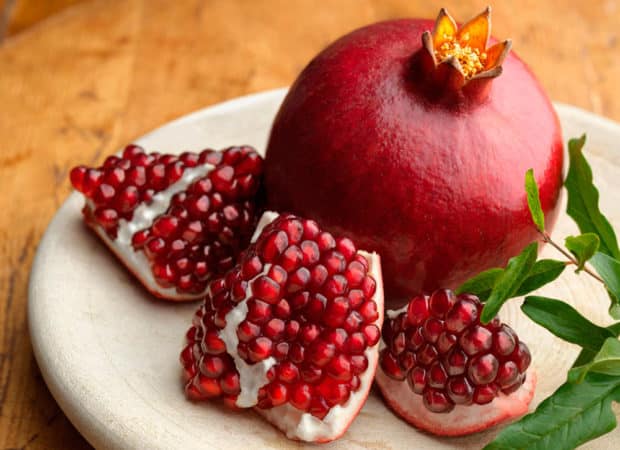
If you pick an unripe pomegranate, it will ripen at home. However, the taste of such fruits will be worse than those ripened on the tree.Therefore, fully ripe pomegranates are usually collected by cutting them from the branches with pruning shears. Stored harvest more than 3 months.
How to identify a ripe pomegranate fruit:
- Grains. In ripe specimens they have an elongated shape with characteristic, clearly visible ribbing.
- Bright shade of peel. Burgundy, pink and red pomegranates are available for sale. Specimens with light spots are not ripe. The darker the peel, the sweeter the fruit.
- Appearance of the peel. The shell should be dry to the touch, without cracks, dents or other damage. The described signs indicate overripeness of the fetus.
- Tapping test. If you knock on a ripe fruit, the peel will make a ringing “metallic” sound. If it is dull, it means the pomegranate is unripe.
- Smell. The richer the aroma emanating from the peel, the less ripe the fruit. Ripe pomegranates practically do not emit any aroma.
- Weight. If the fruit weighs more than it appears, it is ripe. Unripe specimens are light.
- Ovary. Ripe pomegranates are dry, without green impurities.
Conclusion
Pomegranate has spread to all corners of our planet with a suitable subtropical climate. It can be found even in the southern cities of Russia. After all, the exotic tree easily survives frosts down to –15°C and does not shed fruit even in late autumn.
The ripening time of the grant depends on the area of growth and the variety. However, the main harvest season lasts from late September to November.